现代英语语法串讲
英语(一)串讲(文字)

英语(一)串讲(文字)英语一串讲第一部分单元重点句型和常考句子Unit One1. 主语+find + it + 形容词+to do sth. Some people who are very intelligent and successful in their fields find it difficult to succeed in language learning. (line2)They find it easy to practice using the language regularly because they want to learn with it. (line 38)2. It is + 形容词+for sb. +to do sth. It is + 形容词比较级+to do sth.+ than + to do sth. It is necessary for them to learn the language in order to communicate with these people and to learn from them. (Line 36)It is more important for them to learn to think in the language than to know the meaning of every word. (Line 32) 3 ….shows / showed that 从句Language learning research shows that successful language learners are similar in many ways. (Line 14)4. Language learning is different from other kinds of learning. (Line 6) 5. Instead of waiting for the teacher to explain, they try to find the patterns and rules for themselves. (Line19-20) 6. On the other hand, if your language learning has been less than successful, you might do well to try some of the technique outlined above.Unit Two1. … spend + (时间、钱等) on sth. 在…上花费时间、钱等… spend + (时间、钱等) in doing sth. 花费时间、钱等做.. They say that it spends too much on useless and impractical programs. (L35)他们说政府在一些没有用处的、不切实际的项目上花钱太多。
《英语语法》串讲笔记解读
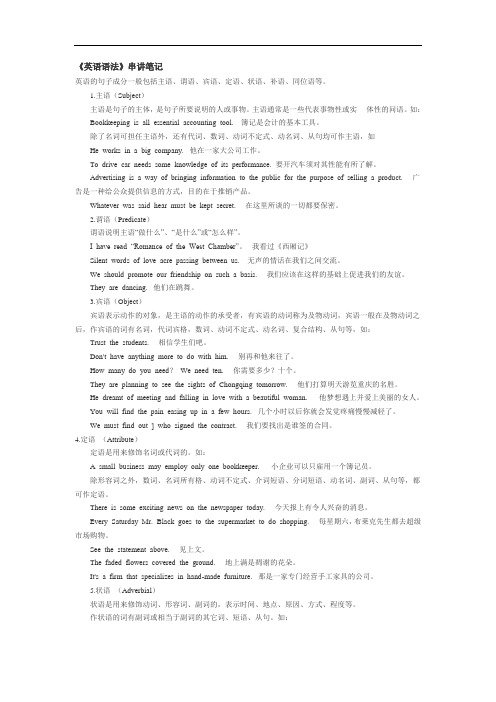
《英语语法》串讲笔记英语的句子成分一般包括主语、谓语、宾语、定语、状语、补语、同位语等。
1.主语(Subject)主语是句子的主体,是句子所要说明的人或事物。
主语通常是一些代表事物性或实体性的问语。
如:Bookkeeping is all essential accounting tool. 簿记是会计的基本工具。
除了名词可担任主语外,还有代词、数词、动词不定式、动名词、从句均可作主语,如He works in a big company. 他在一家大公司工作。
To drive car needs some knowledge of its performance. 要开汽车须对其性能有所了解。
Advertising is a way of bringing information to the public for the purpose of selling a product. 广告是一种给公众提供信息的方式,目的在于推销产品。
Whatever was said hear must be kept secret. 在这里所谈的一切都要保密。
2.谓语(Predicate)谓语说明主语“做什么”、“是什么”或“怎么样”。
I have read “Romance of the West Chamber”。
我看过《西厢记》Silent words of love acre passing between us. 无声的情话在我们之间交流。
We should promote our friendship on such a basis. 我们应该在这样的基础上促进我们的友谊。
They are dancing. 他们在跳舞。
3.宾语(Object)宾语表示动作的对象,是主语的动作的承受者,有宾语的动词称为及物动词,宾语一般在及物动词之后,作宾语的词有名词,代词宾格,数词、动词不定式、动名词、复合结构、从句等,如:Trust the students. 相信学生们吧。
七年级上册英语知识点串讲
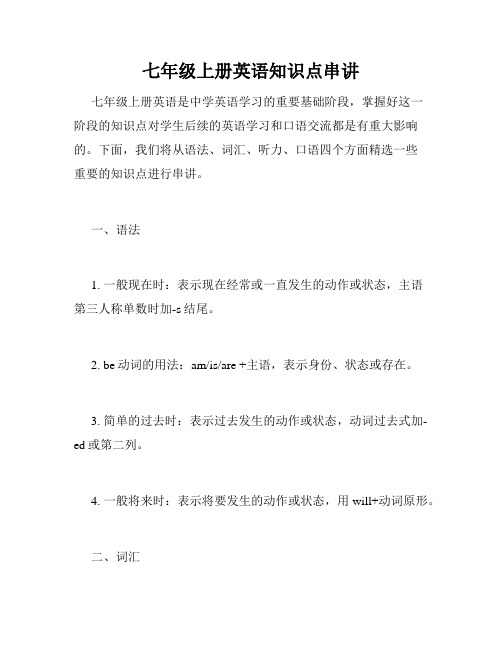
七年级上册英语知识点串讲
七年级上册英语是中学英语学习的重要基础阶段,掌握好这一
阶段的知识点对学生后续的英语学习和口语交流都是有重大影响的。
下面,我们将从语法、词汇、听力、口语四个方面精选一些
重要的知识点进行串讲。
一、语法
1. 一般现在时:表示现在经常或一直发生的动作或状态,主语
第三人称单数时加-s结尾。
2. be动词的用法:am/is/are +主语,表示身份、状态或存在。
3. 简单的过去时:表示过去发生的动作或状态,动词过去式加-ed或第二列。
4. 一般将来时:表示将要发生的动作或状态,用will+动词原形。
二、词汇
1. 数词:用于表示数量的词。
2. 形容词:用于描述人或物的特征的词。
3. 副词:用于修饰动词或形容词的词。
4. 名词:用于表示人、物、地点或事物的词。
三、听力
1. 听力技巧:注重理解含义、注意词义的转化、把握关键信息。
2. 听力材料:短语句、对话、短文等。
3. 听力测试:理解问题、分析选项、选择答案。
四、口语
1. 口语表达技巧:练习口语语感、提高语音语调、注重口语语境。
2. 口语话题:日常交流、购物、旅游等。
3. 口语听说测试:进行日常对话、阅读朗读、情景问答等口语练习。
以上是七年级上册英语较为重要的知识点串讲,学生们应当注意每个知识点的掌握和理解,同时,在学习过程中,应注重练习和听说训练,这样才能真正提高英语水平,提高英语口语交流能力。
初一下语法串讲
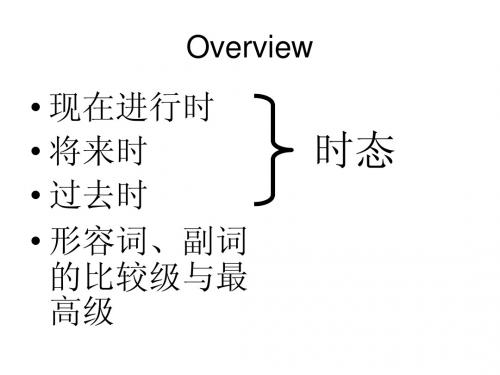
Phrases be more interested in a fat man with a long white beard wear a red suit give presents to children
Sentences
What's happening? Are you getting ready for Spring Festival? It means good luck. We also decorate the doors and window with paper cuts.
1)描述由于现在的事情所导致的将来 ) 发生的事 Look at those black clouds in the sky. It's going to rain. rain get to get wet. Those people are going wet Hurry up! It's getting late. You are going to miss your train. miss your train fall Look out! That ladder is going to fall.
现在进行时
4) 用来描述当前的动向. 用来描述当前的动向. Our children are growing up very quickly. Environment protection is becoming more and more important in our lives.
Exercise
Sentences
Can you hear me? Can you send me a postcard too?
Phrases get ready for learn a dragon dance make lanterns clean the house sweep the floor cook the meal be at work
自考英语语法重点串讲资料

Part 1 动词主要时态和语态表1.一般现在时一般过去时一般将来时主动: do / did / will do被动: are done / were done / will be done2.现在进行时过去进行时将来进行时主动: are doing / were doing / will be doing被动: are being done / were being done3.现在完成时过去完成时将来完成时主动: have done / had done / will have done被动: have been done / had been done现在完成进行时主动: have been doing动词主要时态的意义及运用1.现在完成时,过去完成时和将来完成时英语提示语:up to now, so far, for three years, since 1995, over past ten years,by the end of this week, by the year of 1995汉语提示语:已经,早已,了e.g. We haven’t met each other since last year.By the end of this week, we’ll have finished the task.现在完成进行时:从过去一直持续到现在,没有间断。
汉语提示语:一直e.g. The water has been running the whole night.I’ve often been thinking of you.He’s been worrying about her safety.Obviously she’s been crying.All these years he’s been traveling.过去完成时:1) said, reported, thought等引导的间接引语中。
高考串讲英语知识.doc

高考英语知识串讲第1讲一、Language Points1. sharev.分享、合用:share sth with sbn. 一份,股份 spare a. 业余的,备用的:spare time, a spare tirev. 抽出,匀给:spare me five minutes/spare one of sandwiches for the boyspare no efforts :不遗余力spare no expense :不惜工本save v. 节省,救出2. He felt lucky to have survived the war.3. with sb about/over sth :和某人就某事争论 argue for/against sth :赞成/反对…Sb into/out of (doing) sth :说服某人做/不做某事4. have/make/let/see/watch/listen to+宾+宾补(do/doing/done) get sb to do sth have+宾+宾补(to do/to be done) 5. So+同一主语+助动词 So/neither/nor+助动词+另一主语 So it is/was with+另一主语6. should/ought to/need/could/might/would+do/have done7. except/but/except for/except that/except wh-clause besides/in addition apart from but for=without8. The first time+从句 For the first time :作时间状语 It ’s the first time+that-clause(完成时) the first+名词+to do9. most most of the +n.(pl)/pron. the majority of (the) mostly: 主要地(状) 10. be equal to sth :与…相等 be equal to (doing) sth :胜任(做)某事 equal sth :与…相等 equal sb in sth :在…方面与某人匹敌 11. compar e …to/with … compared to/wit h … 12. a great many several/two dozen/hundred +n.(pl.) (many) dozens of a great many of +the/these/those+n.(pl.) seveal/two dozen of +pron. 13. much too+adj/adv(原级) too much+n.(u.) too many+n.(pl.) 14. 没有被动态 come about(主要用于疑问句、否定句) happen(表示偶然、碰巧之意) sth+ take place(多表示有组织、有计划) break out(指战争、灾害、疾病等的爆发)occur(与happen 通用) It occurs to sb that/to d o …:某人突然想起… 15. n./pron./adj./adv./prep-phrase to do :表将来 With+宾+宾补 doing :表正在进行 Done :表过去 16. 强调句型的判断方法:如果将句子中的“it be ”和“that ”去掉,原句通顺则是强调句,否则就不是强调句。
英语二语法串讲
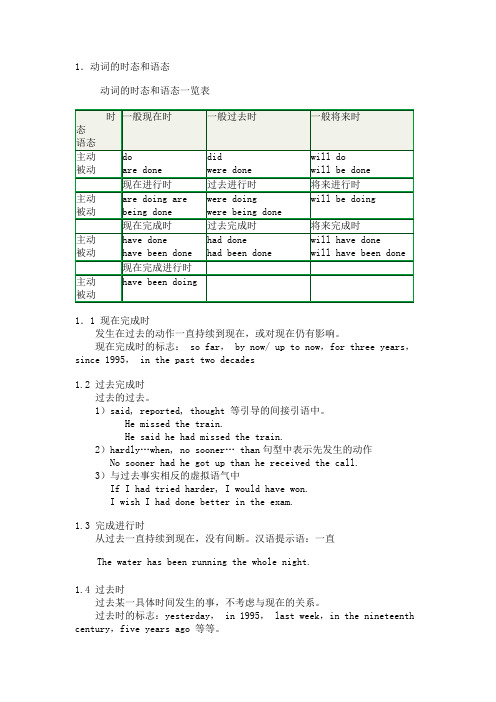
1.动词的时态和语态动词的时态和语态一览表1.1 现在完成时发生在过去的动作一直持续到现在,或对现在仍有影响。
现在完成时的标志: so far, by now/ up to now,for three years,since 1995, in the past two decades1.2 过去完成时过去的过去。
1)said, reported, thought 等引导的间接引语中。
He missed the train.He said he had missed the train.2)hardly…when, no sooner… than句型中表示先发生的动作 No sooner had he got up than he received the call.3)与过去事实相反的虚拟语气中If I had tried harder, I would have won.I wish I had done better in the exam.1.3 完成进行时从过去一直持续到现在,没有间断。
汉语提示语:一直The water has been running the whole night.1.4 过去时过去某一具体时间发生的事,不考虑与现在的关系。
过去时的标志:yesterday, in 1995, last week,in the nineteenth century,five years ago 等等。
2.非谓语动词2.1 非谓语动词一览表2.2. 非谓语动词作状语动词不定式:1)目的状语;2)结果状语I came here to meet you. (目的)He hurried to the rail station only to miss the train. (结果)分词:1) 伴随状语;2)原因状语;3)条件状语 4)让步状语;5)时间状语Walking along the street, he met his old friend. (时间)Being very tired, my father didn’t go out with us. (原因)Made by hand, the silk shirt is very expensive. (原因)Seen from the space, the earth looks like a blue ball. (条件)2.3 非谓语动词,状语从句和独立结构1) Having done their homework, the children began to play. (分词作状语)2) After having done their homework, the children began to play. (连词+分词)3) After they had done their homework, the children began to play. (状语从句)4) With homework done, the children began to play. (独立结构)2.4 非谓语动词作定语1) If there is no choice, there is no decision ___ (make). (to bemade)2) Do you know the man ____ ( stand) in front of the house? (standing)3) The question ____ (discuss) at the moment is very important. (being discussed)4) The bridge ____ (build) in the 1950s is still in good condition. (built)2.5 动名词和动词不定式作主语和表语动名词作主语/表语表示一般、抽象的情况;动词不定时作主语表示具体某次的情况。
语法经典串讲

附加课程一:语法经典串讲讲义食用方法:经过一次课程学习,有好多同学说自己的语法问题比较大,但是确实也没法回炉重造了。
其实,常见的语法问题主要是:(与动词相关)时态,语态,虚拟语气,非谓语动词,定语从句如果单纯讲语法理论肯定无聊而且听不进去,这个讲义帮助大家通过题目回顾常见语法问题,以一个句子解读一个语法现象,快速调取关于语法的记忆。
请大家经常自言自语红色的例句,这些例句既有语法现象,也是工作中常用的语句。
1.时态英文与中文不同的一点是,英文对于时间先后的表意是外显的,表现为动词的时态变化,有16种。
常用时态组合表(4*4)注:例如,矩阵中(1,1)的位置表示“一般现在时”大家在口语里常见的错误一定要避免,需要多练习以下句子:①I have been working in Schneider Electric for more than 7 years.(我在这里工作了7年,现在完成进行时,表明动作work已经持续了7年,还会继续下去,即“现在完成进行时”谈自己的工作经历)②I'm really into cooking/I love cooking/ I am interested in cooking./Cooking is my hobby.(谈论爱好是一般的动作“一般现在时”)2.语态我对语态的理解是:动词与主语的逻辑关系。
主动语态:主语是动词的逻辑主语,即主语是动词的执行者被动语态:主语是动词的逻辑宾语,即主语是动词的被执行者注:不及物动词没有被动语态I disagree with many points made by you.这个句子有两个动词:Disagree:逻辑主语是I ,形成主动关系,即I 执行Disagree,形成主动关系Made:逻辑主语是many points(还原:make many points),many points被执行,形成被动关系Q:如何判断语态?A:我觉得最好的办法是“还原”本来的词组,如果是原本的词组中宾语放到了谓语动词前面,那一般就要用被动语态了。
高中语法知识串讲
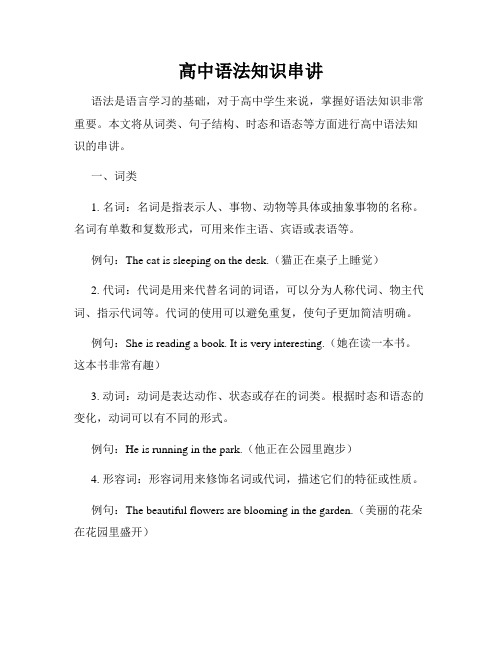
高中语法知识串讲语法是语言学习的基础,对于高中学生来说,掌握好语法知识非常重要。
本文将从词类、句子结构、时态和语态等方面进行高中语法知识的串讲。
一、词类1. 名词:名词是指表示人、事物、动物等具体或抽象事物的名称。
名词有单数和复数形式,可用来作主语、宾语或表语等。
例句:The cat is sleeping on the desk.(猫正在桌子上睡觉)2. 代词:代词是用来代替名词的词语,可以分为人称代词、物主代词、指示代词等。
代词的使用可以避免重复,使句子更加简洁明确。
例句:She is reading a book. It is very interesting.(她在读一本书。
这本书非常有趣)3. 动词:动词是表达动作、状态或存在的词类。
根据时态和语态的变化,动词可以有不同的形式。
例句:He is running in the park.(他正在公园里跑步)4. 形容词:形容词用来修饰名词或代词,描述它们的特征或性质。
例句:The beautiful flowers are blooming in the garden.(美丽的花朵在花园里盛开)5. 副词:副词用来修饰动词、形容词和其他副词,表示时间、地点、程度、方式等。
例句:She speaks English fluently.(她英语讲得很流利)二、句子结构1. 主谓结构:一个句子必须包括主语和谓语。
主语一般位于句子的前面,谓语则位于主语之后。
例句:The sun rises in the east.(太阳从东方升起)2. 主谓宾结构:除了主语和谓语外,有些句子还包括宾语。
宾语位于动词之后,表示动作的承受者或影响者。
例句:She is reading a book.(她正在读一本书)3. 主系表结构:有些句子的谓语动词不表示动作,而是表示状态,这时它后面往往会跟一个表语。
例句:He is a teacher.(他是一名老师)三、时态和语态1. 时态:时态用来表示动作或状态发生的时间。
英语语语法串讲

专转本英语语法考前串讲
【9 】 “of + which/whom”可用来限定名词、代词、分数词、数 词等。 e.g. 1. In the dark street, there wasn’t a single person ____________ she could turn for help. A. that B. who C. from whom D. to whom 2. He paid the boy $10 for washing the windows, most of ________ hadn’t been cleaned for at least a year. A. these B. those C. that D. which
专转本英语语法考前串讲
【6】不定式用法 作表语 不定式可放在be动词后面,形成表语。 例如:My work is to clean the room every day. 作定语 不定式做定语通常要放在被修饰的词后。 例如:I have a lot of work to do. 作状语 in order to, so as to, (如此……以便……) He ran so fast as to catch the first bus. 他飞快地跑以 便赶上第一班车。
专转本英语语法考前串讲
【12】分词作作宾语补足语 分词作宾语补足语,要看分词与宾语的关系。若为 主动关系,则用现在分词;若为被动关系,则用过 去分词。 When I went into the classroom, I saw all the classmates writing composition according to what the teacher said. He had his leg injured in the basketball match yesterday.
备战高考英语语法知识串讲与运用:动词的时态【知识串讲】
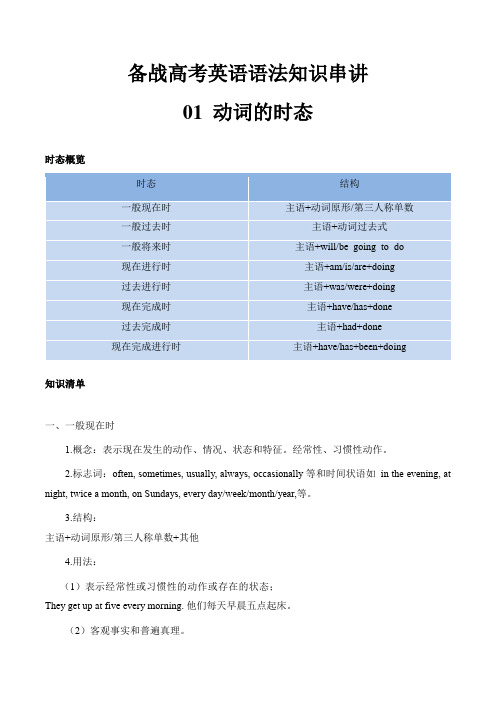
备战高考英语语法知识串讲01 动词的时态时态概览知识清单一、一般现在时1.概念:表示现在发生的动作、情况、状态和特征。
经常性、习惯性动作。
2.标志词:often, sometimes, usually, always, occasionally等和时间状语如in the evening, at night, twice a month, on Sundays, every day/week/month/year,等。
3.结构:主语+动词原形/第三人称单数+其他4.用法:(1)表示经常性或习惯性的动作或存在的状态;They get up at five every morning. 他们每天早晨五点起床。
(2)客观事实和普遍真理。
The earth goes around the sun.(3)表示一个按规定、计划或安排要发生的动作,(仅限于某些表示“来、去、动、停、开始、结束、继续”等的动词)可以与表示未来时间的状语搭配使用。
常见的用法是:飞机、火车、轮船、汽车等定期定点运行的交通方式。
The next flight leaves at 3 o'clock this afternoon.下一趟航班今天下午3点起飞。
How often does this shuttle bus run?这班车多久一趟?(4)在由when, after, before, until, till, as soon as,等引导的时间状语从句或由if, so/as long as, once, even if, although, whether…or…, in case, whatever, whenever, wherever 等引导的条件状语从句中,通常用一般现在时代替一般将来时(主将从现)。
When you finish the report, I will hand it to Mr Ma.等你完成这份报告的时候,我就把它交给马老师。
《英语语法》串讲(最新版)

《英语语法》串讲讲义课程介绍一、课程性质《现代英语语法》是高等教育自学考试英语专业(本科段)的一门选修课,主要面向具有相当于英语专业本科二年级以上水平并有志参加高等教育自学考试英语专业(本科段)考试的学生。
《现代英语语法》理论与实践并重,既是一部语法理论著作,有宏观的理论概述,对英语语言结构作了比较系统的描写。
又可作为教学参考书,它根据教学要求精选语法项目、设计篇章结构,有取有舍,自成体系,既有知识性,又有实践性。
本教程中例子丰富,在历年试题中直接从教材中选择的例句数量相当多,这就要求学员在学习的过程中能确实看懂例子,能真正理解理论并能把理论应用于实践。
二、教材的选用《现代英语语法》课程所选用教材是全国高等教育自学考试指定教材,该书由李基安主编,外语教学与研究出版社出版。
三、章节体系为了便于各位学员复习应考,我们的串讲严格按照教材章节来讲。
共十六章,每章主要以哪种形式命题以及哪些是高频考点我在讲解的什么都会提到,以帮助大家在以后的复习中做到有的放矢,迅速抓住重点内容,以取得事半功倍的效果。
考情分析一、历年真题的分布情况根据对《现代英语语法》近5年考题(注:全国每年统考:4月,有些省份7月还有一次,浙江省每年10月份也有语法考试)分析,可以看出哪些部分是全书的重点章,具体看下列表格中的黑体。
二、题型分析《现代英语语法》的考试题型包括五种:单项选择题、填空题、改错题、改写句子、简答题。
根据对近5年的试题进行分析,可以发现题型有变化,但总的题量没变,仍然是74个题目。
09年4月前(含09年4月)共7大题型:一、单项选择题(本大题共20小题,每小题1分,共20分)二、选择填空题(本大题共8小题,每小题2分,共16分)如:21. were, was, had, animal, animalsSmall amounts of land ________ used for keeping ________. (该例选自0904)三、填空题(本大题共20小题,每小题1分,共20分)A. Fill in the blank with assertive, non-assertive or negative words:29. I think I’ve lost that green scarf of mine; I can’t find it ________.B. Fill in the blanks with the appropriate form of the verb or verb phrase given:34. It is time we ________ (think) about drawing up a detailed plan for the project.四、改错题(本大题共8小题,每小题1分,共8分)五、改句(本大题共13小题,每小题2分,共26分)Rewrite the following sentences as required.六、名词解释(本大题共2小题,每小题2分,共4分)Define the following terms with examples.七、简答题(本大题共3小题,每小题2分,共6分)Answer the following questions.10年4月开始(含1004)共五大题型:一、单项选择题(本大题共20小题,每小题1分,共20分)二、填空题(本大题共28小题,共36分)Section A. Fill in the blanks with the appropriate words given in the group.(共8小题,每小题2分,共16分)Section B. Fill in the blanks with the words given in brackets. Make changes where necessary. (共20小题,每小题1分,共20分)三、改错题(本大题共l 2小题,每小题1分,共12分)四、改句题(本大题共1 2小题,每小题2分,共24分)五、简答题(本大题共2小题,每小题4分,共8分)从以上题型变化分析,我们可以看出1004把09年4月(前)的第二、三题合成了一个大题,并且少了名词解释的题型,因此总的题型少了两个。
中考语法知识串讲 时态 第一讲 一般现在时(中考英语复习)
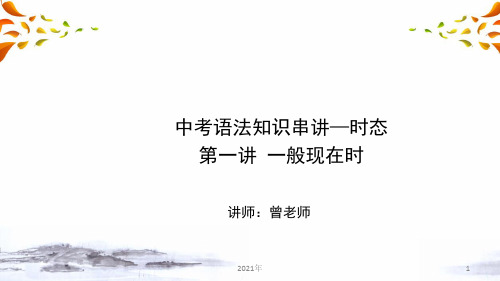
tomorrow? 考查习惯状态 给出标志词
难度系数: ☆ ☆
2021年
8
(2013年河北) 35. Henry will give us a report as soon as he .
考查状语从句 给出标志词
难度系数:☆ ☆ ☆
√A. arrives B. arrived
C. is arriving D. will arrive
中考语法知识串讲—时态 第一讲 一般现在时
讲师:曾老师
2021年
1
2013典例地区 考查内容
考查题型
大致分值
备注说明
2021年
2
2021年
3
一般现在时的形式
肯定 形式
主语 + do/does sth. 主语+ am/are/is + 表语. 主语 + 情态动词 + do sth.
例:You have to stay behind. (12年湖北黄石 单选 35)
2021年
9
复习方略
重 点
难 点
易 混
建议:把标志词记好,把时间状语从句与条件状语从句掌握好!
2021年
10
此课件下载后 可修改编辑
单击输入您的封面副标题
例:Listen, the music sounds sweet. (12年福建福州 选35)
否定 形式
主语 +don’t/doesn’t + do sth. 主语 + am/are/is + not+表语. 主语+情态动词 + not do sth.
问句 形式
do/ does +主语 + do sth? am/are/is + 主语 + 表语? 情态动词 +主语 + do sth?
专四英语语法考点串讲
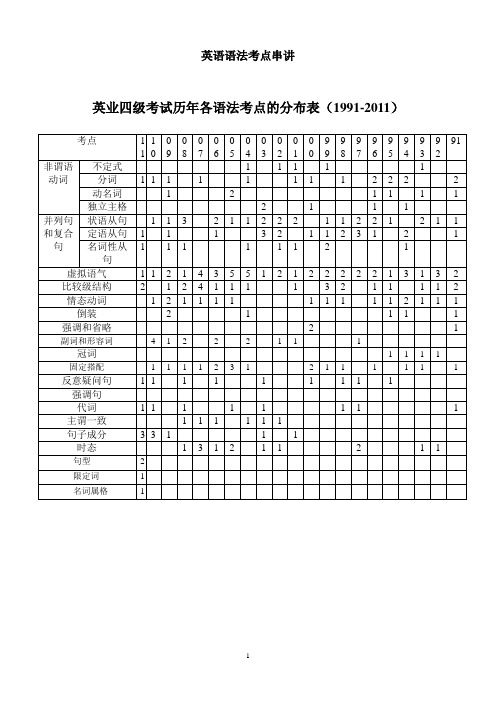
英语语法考点串讲英业四级考试历年各语法考点的分布表(1991-2011)考点11 1987654321999897969594939291非谓语动词不定式 1 1 1 1 1分词 1 1 1 1 1 1 1 1 2 2 2 2 动名词 1 2 1 1 1 1 独立主格 2 1 1 1并列句和复合句状语从句 1 1 3 2 1 1 2 2 2 1 1 2 2 1 2 1 1 定语从句 1 1 1 3 2 1 1 2 3 1 2 1 名词性从句1 1 1 1 1 12 1虚拟语气 1 1 2 1 4 3 5 5 1 2 1 2 2 2 2 2 1 3 1 3 2 比较级结构 2 1 2 4 1 1 1 1 3 2 1 1 1 1 2 情态动词 1 2 1 1 1 1 1 1 1 1 1 2 1 1 1 倒装 2 1 1 1 1 强调和省略 2 1 副词和形容词 4 1 2 2 2 1 1 1冠词 1 1 1 1 固定搭配 1 1 1 1 2 3 1 2 1 1 1 1 1 1 反意疑问句 1 1 1 1 1 1 1 1 1强调句代词 1 1 1 1 1 1 1 1 主谓一致 1 1 1 1 1 1句子成分 3 3 1 1 1时态 1 3 1 2 1 1 2 1 1 句型 2限定词 1名词属格 1专四英语语法考点串讲之一:虚拟语气考点1. If从句中的虚拟语气省略if,从句的语序用倒装,即将were, had或should移至主语的前面,但否定词not不前移。
1、与过去事实相反:从句sb had done,主句sb would(should, could, might)+ have done;1. Had Judy been more careful on the maths exam, she ____ much better results now. 2008A. would be gettingB. could have gotC. must getD. would get2. He would have finished his college education, but he ____to quit and find a job to support his family.2007A. had hadB. hasC. hadD. would have3.___, he would not have recovered so quickly.2005/1995A. Hadn't he been taken good care ofB. Had he not been taken good care ofC. Had not he been taken good care ofD. Had he been not taken good care of4. I ___the party much more if there hadn’t been quite such a c rowd of people there.2004/1996A. would enjoyB. will have enjoyedC. would have enjoyedD. will be enjoying5. All of us would have enjoyed the party much more if there ___ quite such a crowd of people there.2004/2000A. weren’tB. hasn’t beenC. hadn’t beenD. wouldn’t6. ___for the fact that she broke her leg, she might have passed the exam.2002A. Had it not beenB. Hadn’t it beenC. Was it notD. Were it not7. _____enough time and money, the researchers would have been able to discover more in this field.1998a. Givingb. To givec. Givend. Being given8. I was to have made a speech if___.1997A. I was not called awayB. nobody would have called me awayC. I had not been called awayD. nobody called me away9. _____ time, he’ll make a first-class tennis player. 1996A. HavingB. GivenC. GivingD. Had10. We could ___him with a detached house when he came, but he had specifically asked for a small flat.1995A. provideB. have providedC. not provideD. not have provided11. ______you were busy, I wouldn’t have bothered you with my questions. 1994A. If I realizedB. Had I realizedC. I realized thatD. As I realized12. _____ their help, we would not have succeeded.1992A. Hadn't been forB. Had it not been forC. It hadn't been forD. Had not it been for13. If you _____ in such a hurry you sugar into the sauce instead of salt.1992A. were not, would not putB. were, would putC. had been, would have putD. had not been, would not have put14. "Did you hear of his death?'"Yes. If he ___ in time, he ___.”1990A. had been operated on, might not dieB. had been operated on, might not have diedC. were operated on, might not dieD. were operated on,- might not have died2、与现在事实相反:从句sb did(were),主句sb would(should, could, might)+do;1. If there were no subjunctive mood, English _____ much easier to learn.2009A. could have beenB. would beC. will beD. would have been2. “You ______ borrow my notes provided you take care of them,” I told my friend. 2007A. couldB. shouldC. mustD. can3. If you explained the situation to your solicitor, he ________ able to advise you much better than I can.2005A. would beB. will have beenC. wasD. Were4. If I knew Japanese , I ______ for the position.1991A. would applyB. will applyC. may have appliedD. will have applied3、与将来事实相反:从句sb did (should+do或were+to do),主句sb would (should, could, might)+do。
自考英语(二)串讲(珍藏版)

自考英语串讲(二)(珍藏版)上册Grammar & UsageSubject Verb Agreement(Ⅰ)1.主谓一致的三条原则(1)语法一致,即在语法形式上取得一致。
Human beings enjoy learning.Everybody’s understanding is incomplete.(2)意义一致,即根据意义来处理一致关系。
The people there are fighting for the independence of their country.Ten dollars was a lot of money at that time.(3)就近原则,即谓语动词的单、复数形式取决于最靠近它的词语。
There is a pen,two pencils and an eraser in the pencil box.Neither the boy nor his teachers know the answer.2.集体名词作主语时与动词的一致(1)当主语为furniture,equipment,machinery等词时,谓语动词通常用单数。
The furniture in that shop is all made in China.Office equipment is very expensive nowadays.(2)集体名词如people,cattle,police,poultry等往往作复数用。
Some people drive madly in this country.Many cattle have died because of the flood.(3)family,government,class,committee,audience,team,public等词被视作一个整体时,其后的动词用单数;被视为构成整体的个体时,其后的动词则为复数。
中考英语中考语法知识串讲 被动语态 第一讲 一般现在时的被动语态

命题规律
以九个省 2011—2013 年中考题 为例
考点梳理
被动语态的含义
被动语态表示主语是动作的承受者
考梳理
一般现在时的被动语态的构成
am / is / are + 动词的过去分词
考点梳理 一般现在时的被动语态的句式结构
考点梳理 一般现在时的被动语态的句式结构
小结
一 般 现 在 时 的 被 动 语 态
语法知识串讲 被动语态 第一讲 一般现在时的被动语态
讲师:李玉霞
考点透视
一一般般现现在在 时时的的被被动动 语语态态
特殊的被 动语态
被动 语态
含情态动 词的被动 语态
一般过去 时的被动
语态
一般将来 时的被动
语态
现在完成 时的被动
语态
命题规律
以九个省 2011—2013 年中考题为 例
命题规律
以九个省 2011—2013 年中考题为 例
解题技巧
1.根据句意或时间状语判断用什么样的时态
解题技巧 2.根据句意判断用什么样的语态
解题技巧 3.根据主谓一致的规则判断用什么样的be动词
解题技巧 得出答案
解题技巧
得出答案
解题技巧
语法串讲

时态——一般现在时表示现在、经常或习惯的动作或状态和普遍现象、常识或客观真理;一般过去时用于过去某一时间内发生的或过去习惯性的动作或状态;一般将来时表示将要发生的动作或存在的状态,将来打算做的事情;现在完成时表示过去发生的动作造成目前的结果和对现在造成的影响或表示从过去延续至今的动作、状态和习惯等;将来完成时表示将来某时之前业已完成或发生的事情;过去完成时表示过去某时间之前已经发生的动作或状况,即过去的过去。
注意每一种时态与其他时态的交叉使用情况。
英语共有十六种时态,其表现形式如下(以study 考试中出现的一般有以下几种。
一般现在时I、一般现在时一、表示一般性或经常发生的动作或状态1) In general [A],newspapers emphasize current news,whereas [B]magazines dealt [C]more with [D]background materials. 1) C错。
“in general”表示“一般”,所以主句用一般现在时,并列从句的谓语也是表示一般性,所以C处也应用一般现在时,故将其改为deal,而不是过去时dealt。
2) The adult mosquito usually lives for about [A]thirty days,although [B]the life span varied [C]widely with temperature,humidity,and other [D]factors of the environment. 2) C错。
本句的主从句中的“usually”表示“经常”,用一般现在时;而让步状语从句的谓语也是表示同一情况,所以也应当用一般现在时。
故把C处的varied改为varies。
3) Industrial buyers [A]are responsible [B]for supplying [C]the goods and services that an organization required [D]for its operations.D错。
- 1、下载文档前请自行甄别文档内容的完整性,平台不提供额外的编辑、内容补充、找答案等附加服务。
- 2、"仅部分预览"的文档,不可在线预览部分如存在完整性等问题,可反馈申请退款(可完整预览的文档不适用该条件!)。
- 3、如文档侵犯您的权益,请联系客服反馈,我们会尽快为您处理(人工客服工作时间:9:00-18:30)。
现代英语语法串讲Main points of GrammarChapter One - The Structure of the English Sentence1. Present the grammatical units that form a hierarchical order:A text consists of one or more sentencesA sentence consists of one or more clausesA clause consists of one or more phrasesA phrase consists of one or more wordsA word consists of one or more morphemes2. Terms:(1) Morpheme: Morphemes are the minimal meaningful elements.(2) Free morpheme: A morpheme that can occur in isolation is termed a “free morpheme”.(3) Bound morphemes: A morpheme that can only occur in conjunction with at least one other morpheme is termed a “bound morpheme”(4) Root: A root is that part of a word that remains when all affixes have been removed.(5) Stem: A stem has to do with inflectional features and is the part that remains when all inflectional affixes have been removed.(6) Base: A base is any form to which affixes of any kind can be added.3. Words are classified in terms of three factors:the environment, the internal structure, the meaning4. Words classesOpen classes: noun, adjective, adverb, verbClosed classes: determiner, pronoun, preposition, conjunction, auxiliaryMarginal classes: numerals, interjections5. Words in the open classes are determined on the basis of three criteria:meaning (semantic or notional angle), form (morphology), function (syntactic)6. the word-formations:(1) Affixation: Affixation is a kind of word-formation approach that it attaches a lesser morpheme. The general term includes: prefixes, infixes and suffixes.(2) Composition: A compound, the product of composition, is a lexical unit consisting of more than one base and functioning both grammatically and semantically as a single word.(3) Conversion: Conversion is the derivational process whereby an item is adapted or converted to a new word class without the addition of an affix.(4) Blending: Blending is a kind of word-formation that a new word is formed from parts of two other words.(5) Back-formation: Back-formation refers to a similar process only reversed.(6) Shortening: Shortening is a process whereby part of a word is clipped so that the originalword is shortened to a smaller word.(7) Acronyms: An acronym is a word coined by putting together the initial letters of a group of words.7. Phrases:(1) Definition: A phrase consists of one or more than one word, always with a head word which determines the class and the structured way of the phrase. It can be classified into five classes: noun phrase, verb phrase, adjective phrase, adverb phrase, and preposition phrase.(2) Five phrase classes:Noun phrase: consists of a head word (a noun) and one or more optional modifiers. Adjective phrase: consists of an adj. as its head word and optional modifiers.Adverb phrase: consists of an adverb as its head word that can take optional modifiers. Prepositional phrase: consists of a proposition as its head word and optional postmodifiers. Verb phrase: the head of a verb phrase is the head verb or lexical verb. Verb phrase is divided into two types based on the forms: the finite verb phrase and the non-finite verb phrase.8. Clause:Two categories: main clause and subordinate clause9. Sentence:(1) Classes: According to different functions, a sentence can be a statement, a question, a command or an exclamation.(2) Seven basic clause patterns:SV: subject + verbe.g The solider has recovered.SVC: subject + verb + complemente.g I am happy.SVO: subject + verb + objectivee.g She forgot the key.SVOO: subject + verb + objective + objectivee.g He gave me a present.SVOC: subject + verb + objective + complemente.g He calls her little sister.SVA: subject + verb + adverbiale.g The sun rises each day.SVOA: subject + verb + objective + adverbiale.g China is a large country with a long history.Chapter Two Sentence Types1. Four major types of sentences and functions:(1) Declaration: giving information;(2) Interrogative: requiring information;(3) Imperative: requiring actions;(4) Ex clamation: expressing the speaker’s impression of something.2. assertion vs. non-assertion(1) assertive words: some, someone, somebody, something, somewhere, sometime(s), one or the other, still, already, as well, too(2) non-assertive words: any, anyone, anybody, anything, anywhere, ever, either, any more, any longer, yet, either(3) negative Words: no/none, no one, nobody, nothing, nowhere, never, neither, no more, no longer(4) Exercise: convert the sentence as demand:A. I have some news for you.non-assertive: I don’t have any news for you.negative: I have no news for you.B. There is someone waiting for you.non-assertive: There isn’t anybody waiting for you.negative: There is nobody waiting for you.3. Four major classes of question:(1) Yes-No question(2) WH-question(3) Alternative question(4) Tag question4. Two major types of alternative questions(1) YES-NO question: YES-NO question are so called because they can be answered by a simple “Yes” or “No”.(2) WH-question: T he term “WH-questions” covers all question that normally begin withWH-series of words, i.e. what, when, where, why, who(m), whose, which and how. They are sometimes called “information questions”.5. What is the difference of the tag question with the rising tone or falling tone?The tag can be spoken with a rising tone or a falling tone.(1) A tag with a rising tone, the question expresses the speaker’s neutral expectation of the hearer’s response and invites the hearer to verify the truth of the prop osition in the statement. It is a YES-NO question in function.(2) A tag question with a falling tone, the speaker asks for the hearer’s confirmation of the statement. It is like an exclamation.6. Exclamations(1) Two major types of exclamations: What-exclamations and How-exclamations(2) What-exclamation: what + a(n) + adj. + nounHow-exclamation: how + adj. + a(n) + noun(3) Exercises: Turn the following statements into exclamationA. It is a nice day!=> What a nice day (it is)!=> How nice a day (it is)!B. She is very beautiful.=> How beautiful she is!C. He has been working a long time.=> What a long time he’s been working!Chapter Three Noun and Noun Phrase (1): Noun and Number1. Analyze the internal structure of noun phrase.(1) Noun phrase consists of a head word of noun or pronoun, and one or more optional modifiers.(2) Structure: (premodification) + head word + (postmodification)(3) The head word of a noun phrase is a noun or pronoun, which can be modified by various premodifiers or postmodifiers from word to clause.(4) for example:the peoplethe old peoplethe ole people old and sickthe old people in the hospitalall the old people who are receiving treatment2. Noun classes:(1) Noun classes include proper nouns and common nouns.(2) Common nouns include countable nouns and mass nouns.(3) Countable nouns include concrete nouns and abstract nouns.(4) Mass nouns include concrete nouns and abstract nouns.3. Terms(1) Proper nouns: Proper nouns denote individual persons, places, etc. A proper noun normally begins with a capital letter, has no plural form and cannot occur after an article.(2) Mass nouns: Nouns cannot take plural are called mass nouns.(3) Collective noun: Collective nouns refer to a group of people, animal and things, which are usually countable.(4) Unit noun: Unit nouns are a very special class of words that are used to specify the quantities of the modified noun.(5) Plural invariables: Nouns are always occur in plural form.(6) Plural compounds: Three tendencies are at work in the inflection of compounds for plural: pluralize the last element, pluralize the first element and pluralize both the first and the last elements.(7) Singular invariables: Singular invariables are normally invariable singulars, Proper nouns and Mass nouns belong to Singular invariables.4. Number(1) Singular invariables: proper nouns and mass nouns(2) Plural invariables: names of tools and articles of dress consisting of two equal; some collective nouns, geographical names of mountain ranges, specials nouns ending in -s(3) Either case:(4) Exercise: physics, news, stationery, crowdSingular only: physics, news, stationeryBoth singular and plural: crowd5. Unit nouns(1) referring to the shapes of objects: a bar of candy, a blade of grass, a cake of ice(2) referring to the ways in which things are put together: a bunch of flowers/keys, a bundle of straw, a cluster of flowers/islands(3) referring to groups of people: an army of beggars, a band of musicians, a bench of examiners (4) referring to groups of animals: a brood of chickens, a cluster of ants, a flock of birds(5) referring to measurement: a foot of cloth, a kilo of flour(6) referring to containers: a bottle of milk, a bowl of rice, a bucket of water(7) referring to manners, states, etc: a display of courage, a fit of coughing, a flash of hopeExercise:1. Choose the appropriate forms in brackets:(1) The Browns (is, are) moving away on Saturday.(2) No one will fail to marvel at the (snow, snows) of the Himalayas.(3) We visited Niagara (Fall, Falls) last summer.(4) I hate to see you in such (a low spirit, low spirits).(5) My special thanks (goes, go) to Professor Brown, who read the dirst draft of this book and gave me a lot of invaluable (advice, advices).(6) He dug deep in his pocket only to produce two (pence, pennies).(7) There has been an increasing number of (man, men) teachers in primary schools in the past few years.(8) Your politics (seem, seems) to be at variance with mine.(9) The Chinese (is, are) an industrious people.(10) Turn left at the second (crossroad, crossroads).Chapter Four Noun and Noun Phrase: Determiner and Genitive1. Terms:(1) Determiners: Determiners refer to words which are used in the premodification of a noun phrase and which typically precede any adjectives that premodify the head word.(2) Double genitive, also referred to as the “post genitive”, is so called because it is a combination of the genitive and the of-phrase, suc h as a friend of my brother’s.2. Determiners and adjectives are different in many ways, what are they?(1) Determiners usually precede adjectives in premodification;(2) The choice of determiners is often determined by the head word but not that of adjectives;(3) Adjectives describe the head word by showing its characteristics, but determiners determine the head word by identifying or quantifying;(4) Adjectives can postmodify the head word, but not determiners;(5) Adjectives have comparative forms, inflectional or periphrastic, but not determiners.3. Co-occurrence of determiners:(1) Predeterminer + Central determiner + Postdeterminer(2) Key words for each group:Predeterminer: all, both, half, double, twice, three, times, one-third, two-thirds, what, sucha(an), manyCentral determiner: articles [a(n), the], demonstratives (this, that, these, those), possessives (my, your, his, etc), genitives (John’s, the boy’s etc), any, each, either, enough, every, neither, no, some, what, which(ever), whose(ever)Postdeterminer: cardinal numerals (one, two, three, etc), ordinal numerals (first, second, third, etc.), next, last, few (fewer, fewest), little(less, least), many, much (more, most), another, other, several, such(3) Attention: two predeterm iners or two central determiners can’t co-occur, while two postdeterminers can co-occur.4. Please list all the forms of genitives and give some examples:Possessive: Mary’s bookOf-phrase: the book of the classDouble genitive: a classmate of sister’s5. Under what general circumstances do we prefer genitive to of-phrase and vice-versa?In principle, animate nouns, esp. referring to persons, can take genitive form, while inanimate nouns, esp. referring to lifeless objects, can take the form of of-phrase.6. What are the constrains that the double genitive is subject to?(1) the 2nd noun refers to persons, never to objects; e.g a friend of Tom’s(2) the 1st noun has indefinite reference and the 2nd noun is definitee.g a friend of my brother’s(3) the 1st noun can be modified by demonstrative or postmodified by a relative clause: e.g that/ the ideas of your sister’s7. What are generic reference and specific reference?Generic reference and specific reference are two uses of articles. Generic reference indicates the whole species or kind, while specific reference indicates one specific people or thing.Chapter Five Verb and Verb Phrase (1): Tense , Aspect and Future1. Analyze the structure of a verb phrase:(1) The overall structure of a verb phrase may be represented by the following formula:Premodification + Head word(2) Verb phrase is divided into two types: simple verb phrase and complex verb phrase2. Explain the relationship between tense and aspect.(1) Tense: refers to a systematic set of inflectional features that are related to time.There are two tenses: the present tense and the past tense:Aspect: reflects the way in which the verb action is regarded or experienced with respect to/ concerning time. There are two aspec t forms: the progressive aspect and the perfective aspect.(2) Tense points to temporal locations, and aspect marks the state of an action.3. What is the difference between tense and time?Time is a concept and tense is a grammar device. A particular tense form can express different temporal notions in different context.4. What implications does it have when simple present refers to the present? And it use in what situation?(1) It is suitable for the general timeless the general timeless statements or the expression of so-called eternal truths;(2) We can also include examples denoting the present existence or state of affairs;(3) The simple present is also commonly used to refer to something that is characterized by regular recurrence;(4) Another important use of the simple present with reference to the present time is found in the presentation of an event that happens simultaneously with speech.5. What does the simple past referring to the present is used to express?The simple past with reference to the present usually expresses the speaker’s attitude or hypothesis. The attitudinal use normally occurs in independent clauses expressing a less direct question, quest or suggestion and implying an overtone of politeness on the part of the speakers. The hypothetical use is typically found in dependent clauses, expressing something contrary to the given fact or to the speaker’s belief, expectation or assumption.6. What are typical semantic components of the present progressive?Some of the typical semantic components of the present progressive are: duration, simultaneity, temporariness, incompleteness, vividness, emphasis, etc.7. The specific semantic implication of future expression: (P125)will/ shallbe going tobe doingsimple presentwill be dongbe about to dobe to doChapter Six: Verb and Verb Phrase (2): Passive Voice and Subjunctive Mood1. There are four categories with finite form: tense, aspect, voice, and mood;Two voice forms: the unmarked active voice, marked passive voice; three mood forms: indicative, imperative, subjunctive2. What constraints does the passive voice have?(1) Grammatical(2) Semantic(3) Stylistic3. The points about Be-passive and Get-passiveBe-passive: (1) state (2) process (3) on who cause the event (4) stative verb (5) with by-agent Get-passive: (1)event (2) consequence (3) on what happens (4) dynamic verb (5) by-agent left out (6) with adverbial showing consequences lie: eventually, finally, as a result.4. What is pseudo-passive? What differences bare there between it regular passive?(1) It is passive in form but active in meaning(2) Its v-ed is adjectivalized(3) V-ed can be modified by ”very/so”, or occurred in comparative form;(4) Without by-agent(5) With other link verbs like: seem, look, etc.5. Where does passive occur?The structure chosen is often determined by the speaker’s point of view, by stylistic factors and, more often than not, by context that may require a particular ordering of information items in a sentence.6. Under what circumstances do we need to leave out the prepositional phrase of by + agent from a passive voice sentence?(1) The passive voice gives us the option of not mentioning agent;(2) it’s unnecessary to tell who the agent is;(3) wish to conceal the agent’s identity or to distance ourselves from our own action;(4) in accounts of processes and scientific experiments, we often use the passive voice to avoid mentioning the agent explicitly because the focus is on what happens and no t on who or what makes it happen.7. Subjunctive mood falls into 2 major types:(1) be-subjunctive mood(2) were-subjunctive moodMain Points of GrammarChapter 7 Verb and Verb Phrase (3): Model Auxiliaries1. What are the two major semantic categories of modal auxiliaries?According to the semantic categories, modal auxiliaries can be divided into two broad categories: predictive and no-predictive.2. Degree of possibility: (from low to high)mightmaycouldcanshouldought towouldwillmust3. Difference between can and may:(1) In the possibility sense, may is commonly used to refer to something that is actually possible, that is, it indicates that the possibility actually exists in real life. Can, generally expresses a different kind of possibility, one that exists in theory rather than in actuality. (2) May not indicates that it is possible that something is not the case. Can’t indicates the impossibility of a state of affairs and is the negative version of must in the predictive sense.(3) In questions, predictive may is rare, which is usually replaced by can.(4) May is marked for formality while can is preferred in informal situations.4. The differences between “should” and “ought to” in meaning:(1) As expressions of obligation should is more subjective on the basis of his judgment.(2) Ought to is more objective on the basis of moral and social principles(3) Ought to expresses warning, disagreement(4) Should offers friendly adviceExercises:1. They ____ the train yesterday, otherwise he will be here now.A. can have missedB. must have missedC. must missD. can miss答案:B2. They ____ here yesterday.A. can’t beB. must beC. mustn’t have beenD. can’t have been答案:D3. ___ you be happy!A. MayB. MustC. CanD. Would答案:A4. You ____ pay the money, but you ____ do so at once.A. needn’t ….mustB. need ……nee dC. must ……mustD. must ……needn’t答案:D5. ____ there be life on Mars?A. CanB. MustC. MayD. Should答案:A6. They ____ on the project for three weeks by now.A. will workB. will have been workingC. had been workedD. worked答案:B7. You’d t he parcel home. The shop have delivered it if you had asked.A. didn’t need to carryB. didn’t carryC. mustn’t have carriedD. needn’t have carried答案:D8. New machinery ____ arriving tomorrow.A. will beB. isC. areD. shall be答案:B9. ____ you have left your glasses at the office.A. ShouldB. WouldC. CouldD. Can答案:C10. My father ____ such a thing.A. cannot have saidB. might not have saidC. couldn’t sayD. must not have said答案:AChapter 8 Verb and Verb Phrase (4): Non-finite Verbs1. What are non-finite verbs?Non-finite verbs are so-called because they are not marked for tense or for subject-verb concord. There are three types of non-finite verbs: infinitive, -ing participle and -ed participle.2. What is dangling participle?When the subject of a participle is not expressed, it is normally understood to be the subject of the main clause. We call this kind of participle dangling participle.Exercises:1. We hear her ____ the piano upstairs every evening.A. playsB. playingC. playedD. play答案:D2. ____ ask for help, she decided to work it out by herself.A. Rather thanB. More thanC. RatherD. No sooner than答案:A3. It’s not allowed ___ in the room.A. smokingB. to smokeC. smokeD. smoked答案:B4. I don’t mind ____ late at night.A. workB. workingC. to workedD. worked答案:B5. The food ____ rotten fast in such hot weather.A. getsB. is gettingC. will getD. will have got答案:A6. I will go home for a vacation as soon as I ___ my exams.A. finishB. will finishC. finishedD. had finished答案:A7. The bus came after I ___ for about half an hour.A. had been workedB. had been workingC. was waitingD. have waited答案:B8. He regretted ____ her the truth.A. having toldB. to have toldC. had toldD. to tell答案:AReplace the finite clauses in italics by non-finite constructions:9. I’m sure it’ll do you good if you admit that you made the mistake. => I’m sure it’ll do you good if you admit making the mistake. 10. Please advise me which I should choose:=> Please advise me which to choose.11. I only wish I could achieve half your success.=> I only wish to achieve half your success.12. I felt that my mind weight was lifted after he promised.=> I felt my mind weight lifted after he promised.13. Do you anticipate that there will be any real problem in getting support?=> Do you anticipate being any real problem in getting support?14. I remember that I posted the letter.=> I remember posting the letter.15. All the windows which were broken have been repaired.=> All the windows broken have been repaired.Chapter 9 Adjective Phrase and Comparison1. Analyze the structure of adj. phrase and syntactic feature of it:(1) The structure of adjective phrase:premodification + head word + postmodification(2) The premodification is often adv, and the post can be: adv, prep. phrase, finite clause, or non-finite clause.(3) Adjective phrase can serve as attributives and predictives:When it serves as attributives, adj. phrase occurs between a determiner and a noun, such as, a pretty girl.When it serves as predictive, adj. phrase can be a subject complement or an object complement.2. The semantic classification of adjective:Adjectives can be classified in terms of three scales: stative/dynamic, gradable/non-gradable, and inherent/non-inherent. Besides, adjectives bear other semantic features as well as restrictive/ non-restrictive and marked/unmarked.3. What are restrictive and non-restrictive adjective? Explain with examples.(1) A restrictive adj. helps identify the noun by describing its distinctive qualities; while a non-restrictive provides additional information which is usually not essential for the identif ication of the referent.(2)In “a fat woman”, “fat” is a restrictive adjective; it can identify the woman from those women who are not fat. In “my fat wife”, “fat” is a non-restrictive adjective, and it proves additionalinformation. “fat” can’t identify my wife from other women (You can’t say a f at woman must be wife.)4. Ordering of premodifying adjectives:Zone I: Intensifying adjectivesZone II: Gradable adjectivesZone III: Color adjectives and participlesZone IV: Denominal adjective5. Three degree of comparison:(1) positive degree: as….as…..(2) comparative degree: more…. than….(3) superlative degree: the most …….Exercises:1. I can give you copies of this book as many as you want.=> I can give you as many copies of the book as you can.2. You may have fresh water as much as you like from here.=> You may have as much fresh water as you like from here.3. Mr. White is a much more learned professor than his students.=> Mr. White is a professor much more learned than his students.4. He likes to order food more than he can eat.=>He likes to order more food than he can eat.5. We need people fewer than there are here.=> We need fewer people than there are here.6. They have done as twice as much work as us.=> They have done twice as much work as us.Chapter TenExercises:1. Michael has remarkable talent ____ basketball. (for)2. Many of them died ____ the disease. (of)3. He aimed his gun ____ me. (at)4. I have no objection ____ his staying in the library as long as he keeps silent. (to)5. ____the two books, she also brought a dictionary. (Besides)6. An objective law is independent ___ man’s will. (on)7. There is no exception ____ the rule. (to)8. She sat ____ the three children. (among)9. London is situated ___ the River Thames. (on)10. He came __ a car and backed ___ bus. (in, by)Chapter Eleven Coordination and Subordination1. Coordination: Coordination is realized by coordinators which join units at the same level.2. Subordination: Subordination, realized by subordinators, involves the linking of units at different levels so that they form a hierarchy. A subordinator introduces a subordinate clause which is attached to the main clause.Exercises:1. Come ___ have tea with us. (and)2. Give me five minutes ___ and I’ll finish the work. (or so)3. ____ they want a house, we would rather live in a flat. (White/Whereas)4. He never came ____ when he is in trouble. (except)5. I think it best ___ you should stay here. (that)6. I shall never forget the ___ New China was founded. (when)7. The reason ___ he did that was unacceptable. (why)8. Is there anything wrong in ___ I said. (what)9. ___ they went, they were warmly received. (Wherever)10. It was raining again, ___ is bad for our crops. (which)Chapter Twelve Relative Clause1. What are the differences between restrictive relative clause and non-restrictive relative? (1) The restrictive relative clause is an integral part of the noun phrase and gives essential information for the identification of what its antecedent refers to.(2) The non-restrictive relative clause merely offers additional information which is not needed to identify the person or thing we are talking about. Non-restrictive relative clauses often set off in wring by commas, and the clause can’t be introduced by “that” or “a zero relative pronoun).2. What is double relative clause?It is used to cover all the verb forms that express assumptions contrary to the given fact or not likely to be materialized, and becomes a far less important verbal category than was suggested.Exercises:1. He ___ laughs last laughs best. (who)2. He denied seeing the murder suspect, ____ turned out to be true. (which)3. This is the best biography ___ I have read of Churchill. (that)4. This is the place ____ they stayed for the night. (where)5. The woman about ___ we talked has just given birth to quintuples successfully. (whom)6. Combining sentences into one that contains a relative clause:My brother gave up smoking. That delighted his wife and children.=>My brother gave up smoking, which delighted his wife and children.Chapter Thirteen Adverbials1. Terms(1) Adjunt is a word or a group of words which we add to a clause to say something about the circumstances of an event or situation, for example, when, where or how it occurs.(2) Disjunct: Disjuncts convey a comment on the content of the clause to which they are peripherally attached.Exercises (for Chapter 13, 14, 15, 16 )。
